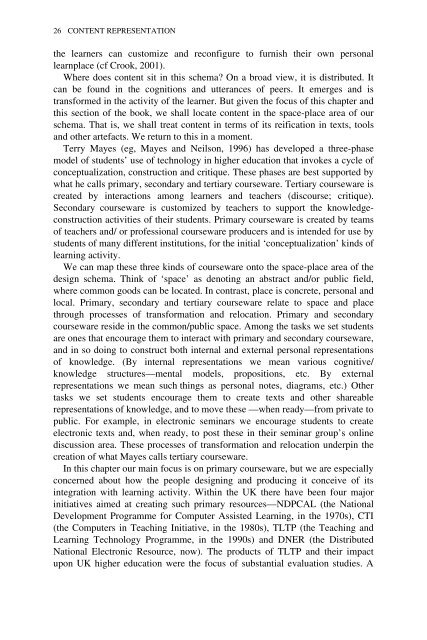teaching_and_learning_with_technology
teaching_and_learning_with_technology
teaching_and_learning_with_technology
Create successful ePaper yourself
Turn your PDF publications into a flip-book with our unique Google optimized e-Paper software.
26 CONTENT REPRESENTATION<br />
the learners can customize <strong>and</strong> reconfigure to furnish their own personal<br />
learnplace (cf Crook, 2001).<br />
Where does content sit in this schema? On a broad view, it is distributed. It<br />
can be found in the cognitions <strong>and</strong> utterances of peers. It emerges <strong>and</strong> is<br />
transformed in the activity of the learner. But given the focus of this chapter <strong>and</strong><br />
this section of the book, we shall locate content in the space-place area of our<br />
schema. That is, we shall treat content in terms of its reification in texts, tools<br />
<strong>and</strong> other artefacts. We return to this in a moment.<br />
Terry Mayes (eg, Mayes <strong>and</strong> Neilson, 1996) has developed a three-phase<br />
model of students’ use of <strong>technology</strong> in higher education that invokes a cycle of<br />
conceptualization, construction <strong>and</strong> critique. These phases are best supported by<br />
what he calls primary, secondary <strong>and</strong> tertiary courseware. Tertiary courseware is<br />
created by interactions among learners <strong>and</strong> teachers (discourse; critique).<br />
Secondary courseware is customized by teachers to support the knowledgeconstruction<br />
activities of their students. Primary courseware is created by teams<br />
of teachers <strong>and</strong>/ or professional courseware producers <strong>and</strong> is intended for use by<br />
students of many different institutions, for the initial ‘conceptualization’ kinds of<br />
<strong>learning</strong> activity.<br />
We can map these three kinds of courseware onto the space-place area of the<br />
design schema. Think of ‘space’ as denoting an abstract <strong>and</strong>/or public field,<br />
where common goods can be located. In contrast, place is concrete, personal <strong>and</strong><br />
local. Primary, secondary <strong>and</strong> tertiary courseware relate to space <strong>and</strong> place<br />
through processes of transformation <strong>and</strong> relocation. Primary <strong>and</strong> secondary<br />
courseware reside in the common/public space. Among the tasks we set students<br />
are ones that encourage them to interact <strong>with</strong> primary <strong>and</strong> secondary courseware,<br />
<strong>and</strong> in so doing to construct both internal <strong>and</strong> external personal representations<br />
of knowledge. (By internal representations we mean various cognitive/<br />
knowledge structures—mental models, propositions, etc. By external<br />
representations we mean such things as personal notes, diagrams, etc.) Other<br />
tasks we set students encourage them to create texts <strong>and</strong> other shareable<br />
representations of knowledge, <strong>and</strong> to move these —when ready—from private to<br />
public. For example, in electronic seminars we encourage students to create<br />
electronic texts <strong>and</strong>, when ready, to post these in their seminar group’s online<br />
discussion area. These processes of transformation <strong>and</strong> relocation underpin the<br />
creation of what Mayes calls tertiary courseware.<br />
In this chapter our main focus is on primary courseware, but we are especially<br />
concerned about how the people designing <strong>and</strong> producing it conceive of its<br />
integration <strong>with</strong> <strong>learning</strong> activity. Within the UK there have been four major<br />
initiatives aimed at creating such primary resources—NDPCAL (the National<br />
Development Programme for Computer Assisted Learning, in the 1970s), CTI<br />
(the Computers in Teaching Initiative, in the 1980s), TLTP (the Teaching <strong>and</strong><br />
Learning Technology Programme, in the 1990s) <strong>and</strong> DNER (the Distributed<br />
National Electronic Resource, now). The products of TLTP <strong>and</strong> their impact<br />
upon UK higher education were the focus of substantial evaluation studies. A


